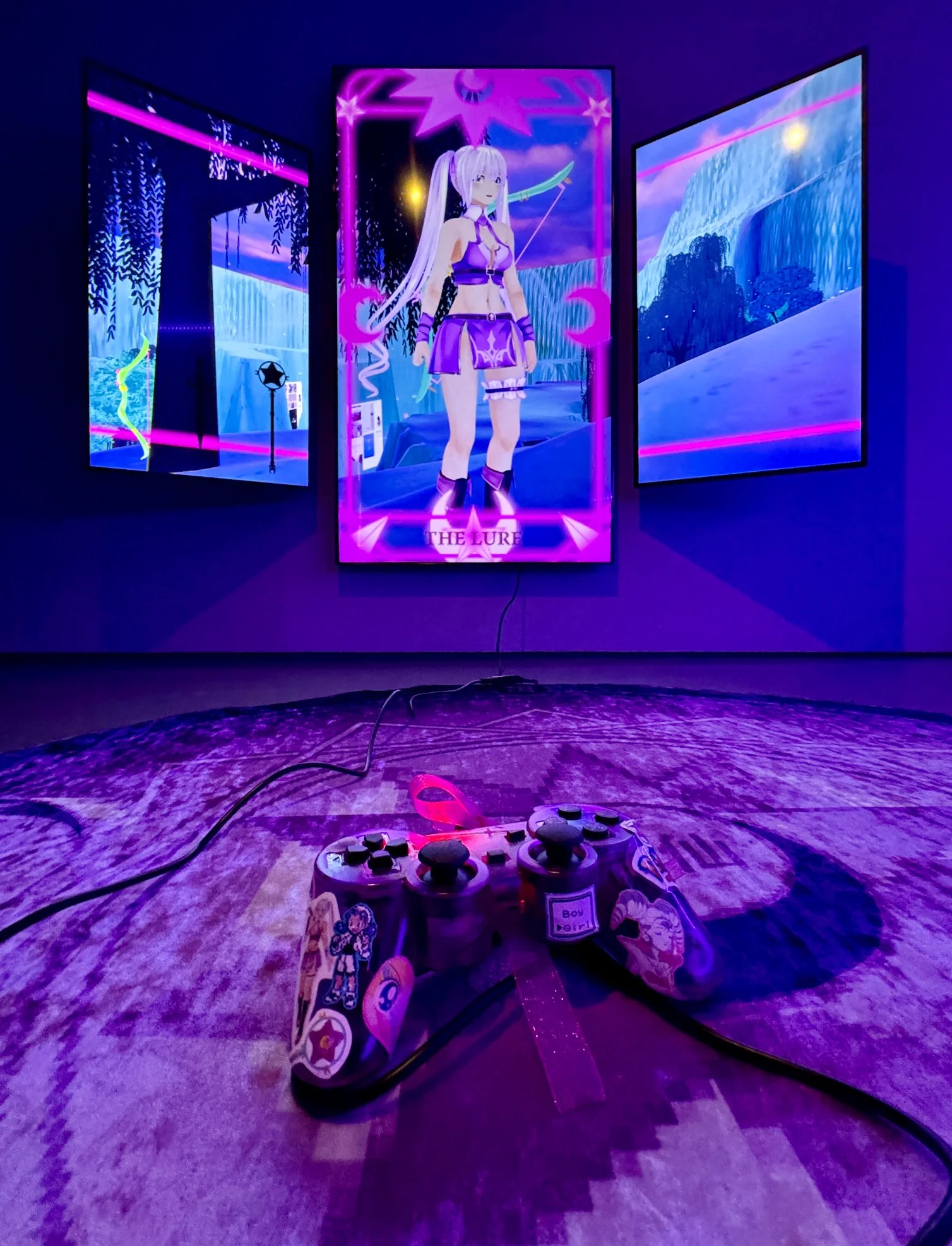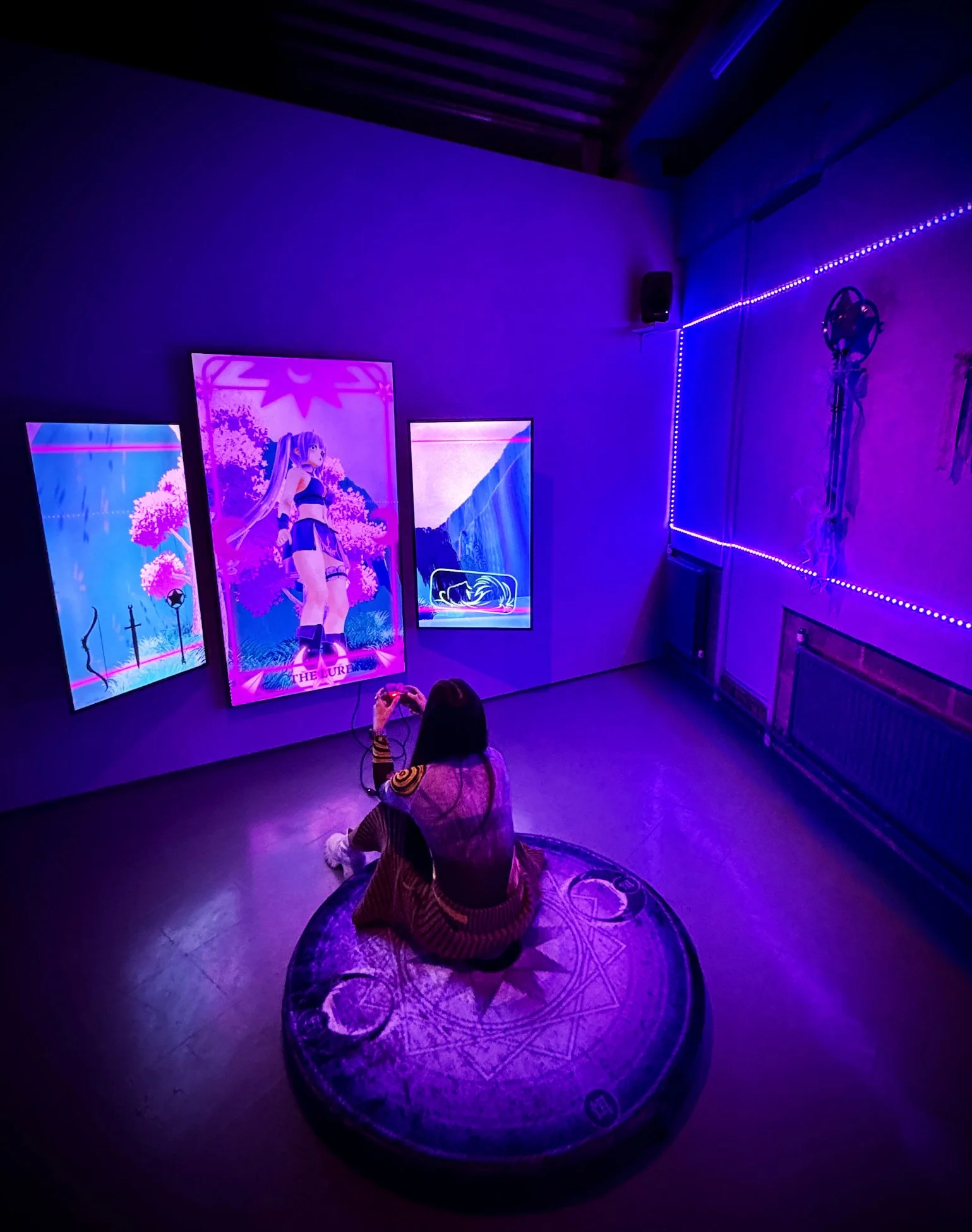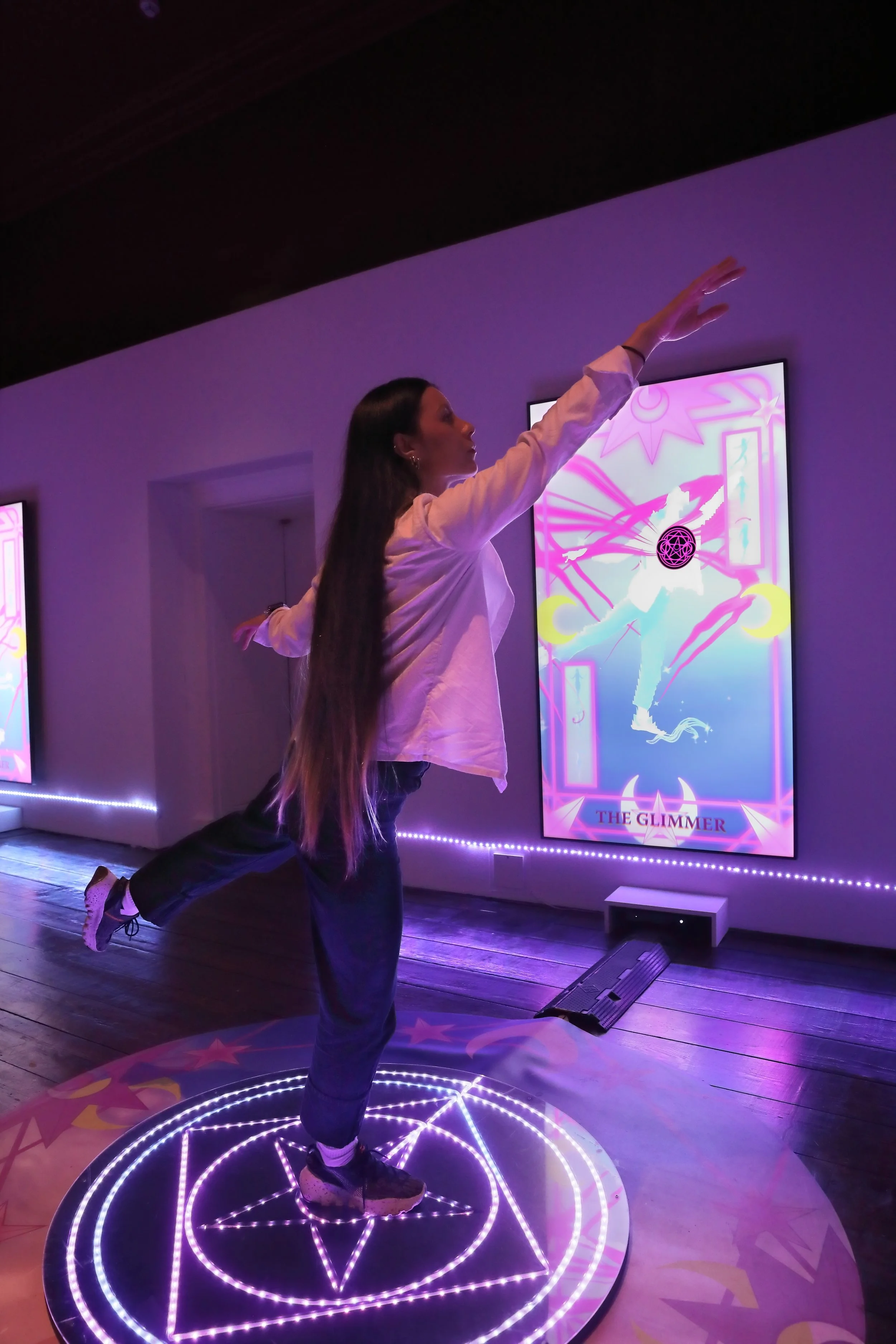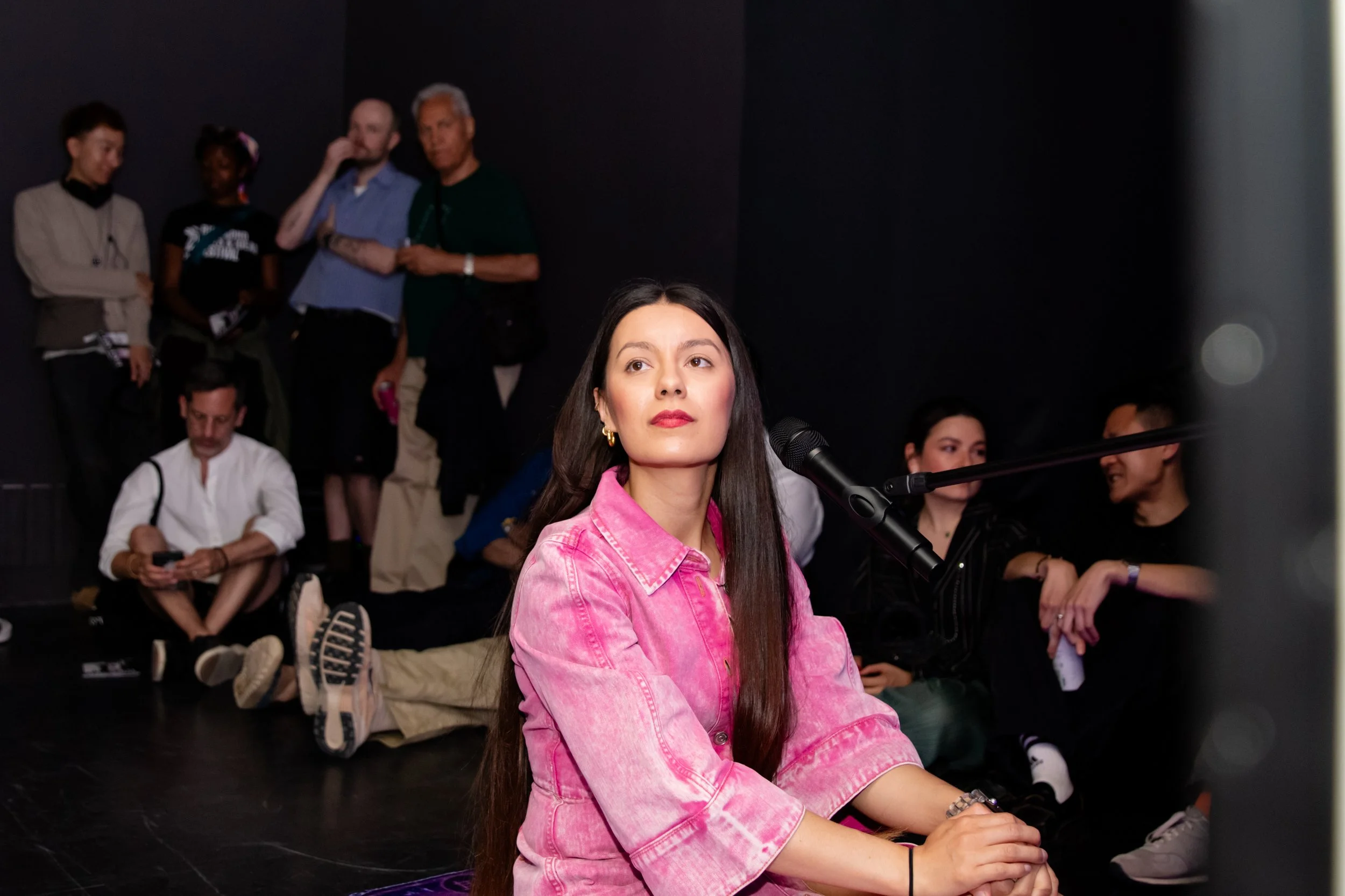The Alluring & The Liminal: In Conversation with Sian Fan
Sian Fan is an award-winning interdisciplinary artist whose practice blends performance, new media, and installation. She’s an artist-in-residence at Somerset House Studios and was the V&A Museum’s Digital Wonderlands resident from 2021-22. Her work has been exhibited at institutions including the Tate Modern and V&A, and she has produced works with platforms such as Channel 4 and the BBC. Her work examines movement, the body, and technology in the digital age.
Sian Fan performing a playthrough of her art piece Lure during LOST ART’s magazine launch event at Gazelli Art House. Image Credit: Koice Media
Nina-Sophia Miralles: Just for context, could you tell us a bit about your work?
Sian Fan: I class myself as an interdisciplinary artist, which is really just my way of being greedy in that I like to be free to work across all mediums.
That being said, I gravitate to performance and digital, and being a child of the Nineties and Noughties, I’m also inspired by early digital culture and the nostalgia surrounding it. My work reflects on the pervasiveness of technology and how it contrasts with the physicality of being human, for better or for worse. In mixing these mediums, our physical and spiritual sides collide with our digital presence.
NSM: When you went into art were you aware of an identity as a digital artist? Or did you just want to play with that new technology?
SF: My background is in performance, so I actually fell into the world of digital art. However, my curiosity for the digital world was intrinsic; I grew up with a connection to, and fascination with, technology. But what I found really crucial in choosing the path of an artist was my desire to tell my own stories rather than enacting someone else’s, which would’ve been the traditional pathway had I pursued performing arts.
That being said, from my performance experience I learnt to use stagecraft that involved technology intimately. I found it fascinating to layer materials over the body, seeing how lights and projections and sounds interacted. I didn’t consciously decide to become a digital artist—it was just the natural medium for me to explore these ideas with.
NSM: Tell me about your upcoming show at Gazelli Art House…
SF: I’ll be doing a performative playthrough of a recent piece called Lure, my most Nineties- and Noughties-inspired work to date.
It’s a three-screen video game with portrait screens surrounding the viewer like a vanity mirror. You play as a hyper-femme anime character, navigating through a hyper-feminine space that contrasts with the typically masculine style of video games. It inverts the idea of a piece being violent or goal-based—it’s more of a tranquil experience, like a form of cosy gaming.
‘[Lure] inverts the idea of a piece being violent or goal-based—it’s more of a tranquil experience, like a form of cosy gaming.’ Image Credit: Sian Fan
It explores the allure of playing as a female character for the first time, and how it changes your sense of beauty, self and identity, and leaves traces in the physical world. And whereas the fantasy games I adored growing up featured weapons and combat, the three weapons you’ll find in this game are decorated with beautiful effects, but are, crucially, non-functional.
And—spoiler alert—when you collect the final weapon, the platform you're stood on disappears, and you fall through this rabbit hole until you eventually respawn at the beginning. There's no right or wrong, there's no mistakes.
A lot of it comes out of a key memory I have about a Game Boy game called Pokémon Crystal, the very first edition where you could play as a girl, as opposed to just having a default male character. Lure traces that journey from seeing oneself represented in virtual spaces. There’s the fallout that comes from such representations too, progressing to creepy AI dancing girls to sexualised cosplay to VTubers who present as young girls but who could actually be 80-year-old men, for all we know. Lure brings together the light and the dark, the full trajectory of what it means to be a ‘girl’ online.
NSM: And can the audience play?
SF: Yeah, they can! It has an old-school PlayStation controller, pink and translucent and covered in stickers, and you sit on this massive velvet floor cushion. It’s an intimate space, as though you’re at home gaming and learning about yourself through what you see online.
NSM: What’s the process of turning an idea into a project like this?
SF: This work is a collage of different things brought together, but everything always starts with the concept. Being a nerdy introverted kid, I feel like I have tangible memories of exploring these virtual spaces, and these experiences did important work in developing my identity and sense of the world. I wanted to think about the specificity of what it was like to be a girl interacting in these spaces. It was a moment when, suddenly, there were different representations popping up that were powerful and meant a lot to me, and I unashamedly adored a lot of the imagery that I was seeing. I thought it was utterly seductive.
‘A digital body can cycle on relentlessly. It’s limitless, machinic, and that makes it interesting.’ Image Credit: Sian Fan
But, over time, I started considering the problematic qualities woven through it, allowing them to coexist with the positive memories I still have. So it began with this single concept, but examining the medium made this project explode outwards into the strange technological space we’re in now.
NSM: Talk to me about the human body: what does it mean to extend it in digital ways that can’t be achieved physically?
SF: That’s ultimately a question about what the digital can do differently to the physical. In contemporary culture we like to emulate the human body in the digital, but it's always a poor impersonation. I became really interested in how technology can enhance physicality and especially in glitches and errors, because they’re the intrinsic texture of the digital. We think of the digital world as something smooth, almost frictionless, but once you begin to untangle it, it’s inherently fractured into pixels, laden with the possibility of errors.
So, what then can a digital body do that mine can’t? There are physical limitations to the human body: your joints have limits, and there’s restrictions to how you can move without injuring yourself. But a digital body can cycle on relentlessly. It’s limitless, machinic, and that makes it interesting.
‘[Lure] explores the allure of playing as a female character for the first time, and how it changes your sense of beauty, self and identity, and leaves traces in the physical world.’ Image Credit: Dan Pluck
NSM: I'm so interested in the concept of a space beyond our physical realm. In the past, we’d think of non-physical planes as something spiritual, but nowadays we’re more likely to associate it with digital worlds. What do you make of this?
SF: I really enjoy the strange parallels between the spiritual and digital: they're ephemeral. We like to be binary and separate the digital or spiritual from ‘real’ physical existence. But like my interdisciplinary work, things entangle no matter how much we try to make them tidy, and it’s this messiness that defines us. I like pulling that apart.
NSM: A lot of what you describe feeds into people’s fears about how ‘real’ our online existence has become, and where the boundary lies. What would be your take on that?
SF: This debate is at its most interesting when you look at how the physical and the digital coexist and coalesce. It’s worth acknowledging that the digital has a physicality to it, even though we sometimes pretend that it doesn't. On the most basic level, all this information comes to us through cables and servers, but this physicality is concealed. I'm curious about acknowledging these hidden physicalities, because it stops us isolating virtual experiences to virtual spaces.
These experiences bleed out, and they leave a mark. We have an increased presence in virtual spaces, but one won’t replace the other. There will always be appetite for both experiences. When two things meld together, it’s always going to be more interesting than when they’re isolated.
NSM: Your work isn’t traditional visual art. How do you find audiences responding to it?
SF: It’s always situational, and that’s what makes the art world exciting. You get a different kind of audience depending on where a work’s placed. Lure was initially a commission for a university gallery called Art Exchange; the people seeing the work were all quite young and interested in gaming and technology. It had this beautiful energy where everyone came with loads of enthusiasm and spent quite a lot of time with the piece.
Whereas at spaces like the V&A, you’re showing works to more traditional gallery audiences. It does depend a bit on environment and demographic—though I love to see people forgetting themselves, waving their arms and leaping around. Naturally, others will say, ‘Oh, I'm just gonna watch’. That's a valid way of engaging. It's just slightly different: I've got two brothers, and growing up, you’d take turns playing the game, and watching them playing was its own kind of experience. But with art you get out what you put in: if you want to dig deep, you can get lots from it.
‘It’s a way for the virtual to bleed into our reality and, hopefully, transform it.’ Image Credit: Koice Media
NSM: Is there a way that an art collector can acquire your work despite most of it being performative? Is this even something that’s important to you?
SF: I make works selfishly. Each piece begins with my own curiosity, and making art is how I unpack my own identity. But outside that central compulsion, I do consider how I’ll communicate what I want different audiences to take from it. There also need to be points of entry for someone that wants to interact with it, and points of entry for someone that wants to watch. Equally, I want physical artefacts that are part of the virtual experience, like models of the virtual weapons that’ll appear in the game, to also be displayed in the gallery.
Having these artefacts seep out of virtual space and be distilled into an object is a way of honouring how virtual memories have real consequences, and it also provides objects that collectors can take home. For Lure, I’ll be displaying models at Gazelli that are the weapons in the game.
I’ve made these physical works by 3D-printing them, which seems apt since they’re digital objects sculpted in virtual space that are now here, in our plane. Some will be talismans or charms, others will look like jewels, and they all exist for the pleasure of appreciating a tactile object in your hands. It’s a way for the virtual to bleed into our reality and, hopefully, transform it.





